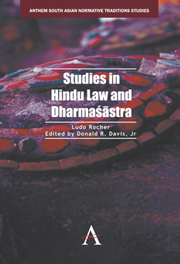Book contents
- Frontmatter
- Contents
- Foreword by Richard W. Lariviere
- Preface
- Abbreviations
- Note on the Edition
- Introduction
- PART ONE THE NATURE OF HINDU LAW
- PART TWO GENERAL TOPICS OF HINDU LAW
- PART THREE HINDU LEGAL PROCEDURE
- PART FOUR TECHNICAL STUDIES OF HINDU LAW
- PART FIVE ANGLO-HINDU AND CUSTOMARY LAW
- Indian Response to Anglo-Hindu Law
- Can a Murderer Inherit his Victim's Estate? British Responses to Troublesome Questions in Hindu Law
- Reinterpreting Texts: When Revealed Sanskrit Texts Become Modern Law Books
- Father Bouchet's Letter on the Administration of Hindu Law
- Jacob Mossel's Treatise on the Customary Laws of the Veḷḷāla Cheṭṭiyārs
- Bibliography
- Index
Jacob Mossel's Treatise on the Customary Laws of the Veḷḷāla Cheṭṭiyārs
from PART FIVE - ANGLO-HINDU AND CUSTOMARY LAW
Published online by Cambridge University Press: 05 February 2013
- Frontmatter
- Contents
- Foreword by Richard W. Lariviere
- Preface
- Abbreviations
- Note on the Edition
- Introduction
- PART ONE THE NATURE OF HINDU LAW
- PART TWO GENERAL TOPICS OF HINDU LAW
- PART THREE HINDU LEGAL PROCEDURE
- PART FOUR TECHNICAL STUDIES OF HINDU LAW
- PART FIVE ANGLO-HINDU AND CUSTOMARY LAW
- Indian Response to Anglo-Hindu Law
- Can a Murderer Inherit his Victim's Estate? British Responses to Troublesome Questions in Hindu Law
- Reinterpreting Texts: When Revealed Sanskrit Texts Become Modern Law Books
- Father Bouchet's Letter on the Administration of Hindu Law
- Jacob Mossel's Treatise on the Customary Laws of the Veḷḷāla Cheṭṭiyārs
- Bibliography
- Index
Summary
1. On March 8, 1720, at the age of fifteen, Jacob Mossel (November 28, 1704-May 15, 1761) left Texel in Holland en route for Batavia, as a young sailor on board “de Haringtuijn” of the Chamber” Enkhuizen. He arrived in Batavia on September 24, 1720.
On May 7, 1721 he sailed westward again, toward Negapatam which had been captured by the Dutch from the Portuguese in 1658 and was to remain one of their main Indian possessions until 1781. He spent about twenty years in this town, building up a successful career which, in 1740, led to the post of “Raad extraordinair van Nederlandsch Indië” (Counsel extraordinary of the Netherlands Indies). Here is a survey of the positions he successively held at Negapatam:
1724 Assistant (“Assistent”)
1725 Book-keeper (“Boekhouder”)
1730 “Factor”
1730 Sub-merchant (“Onderkoopman”)
1732 Merchant (“Koopman”)
1736 Head Merchant (“Opperkoopman”)
1738 First Head Merchant (“Eerste opperkoopman”)
1738 Governor and Director of Coromandel (“Gouverneur en Directeur van Coromandel”)
An even more brilliant career was to follow after he returned to Batavia in 1742; he was elected Governor-General in 1750. However, this part of Mossel's life, as well as his renewed but unsuccessful contact with India in 1759, lie beyond the scope of this study.
- Type
- Chapter
- Information
- Studies in Hindu Law and Dharmasastra , pp. 699 - 718Publisher: Anthem PressPrint publication year: 2012



